OEC History
The Story Begins Here – Oakdale Electric Cooperative’s  History
History
The history of the Oakdale Electric Cooperative cannot be dug out of official minutes, files, or memories without first trespassing upon the history of rural electrification in Wisconsin. It is known, of course, that the machinery of state and federal governments was first put into gear in Washington and Madison, but the very core of the rural electrification program in Wisconsin took shape in the Oakdale Community Club hall on October 19, 1935. Only a week longer than five months had elapsed since the Rural Electrification Administration (REA) was created by President Franklin D. Roosevelt, on May 11, 1935. This action recognized that support was needed to help rural areas become electrified. But it was the self-sufficient, enterprising residents of rural areas who worked together - many by the sweat of their brows - to form cooperatives and bring electricity to their homes, schools, churches, farms and businesses.
On April 24, 1936, the Oakdale Electric cooperative was organized and incorporated, with W. E. Rabe, R. E. Dunlap, F. E. Kuckuck, F. W. Habelman, O. O. Humboldt, and J. A. Gabower signing the Articles of Incorporation. Only a handful of farmers had signed into membership on the date of the organization meeting, but there were enough to constitute a quorum and elect a board of directors. The Oakdale Electric Cooperative was born and in the space of a few hours had become a legal entity under the cooperative laws of Wisconsin.
Oakdale Electric Cooperative has come a long way since 1937 when the cooperative's power lines were energized 48 miles of line on July 14, 1937 to light up the landscapes of our beautiful rural central Wisconsin counties. Life in the days before the late 1930's was dark and filled with manual labor from dawn to dusk for rural folks. While electricity had come to many towns and cities, it remained elusive in more distant areas because existing utilities found it unprofitable to bring it to rural areas. By the end of 1938, Oakdale Electric Cooperative was serving 221 members.
How people formed their cooperatives and brought electricity to rural areas is one of the nation's greatest examples of economic democracy. Men and women petitioned, educated and organized to bring power to their communities. They drew lines on rough paper maps. They secured signatures for sign-ups. They obtained pledges of land for the paths of the lines so the cooperative could build power lines to serve them and their neighbors. Line crews, often aided by eager members in the community, cleared rights-of-way and dug holes, while others followed with poles and hardware. Last came the crews to hang the line.
Today, our cooperative still provides essential power to a growing five county area. While the cooperative has progressed and continues to prepare for the future, Oakdale Electric Cooperative remains committed today to the same principles upon which cooperatives were founded. Owned by the members we serve, we are a local business formed to provide affordable access to electricity. We return any margins in the form of capital credits to our members, and the cooperative is governed by a board of directors elected by the membership. And while the primary purpose of the cooperative is to provide affordable electricity, our greater, guiding purpose is to contribute to the communities we serve. That's the higher calling of an electric cooperative like Oakdale Electric Cooperative. And that's why we're proud to be a part of all the communities we serve.
